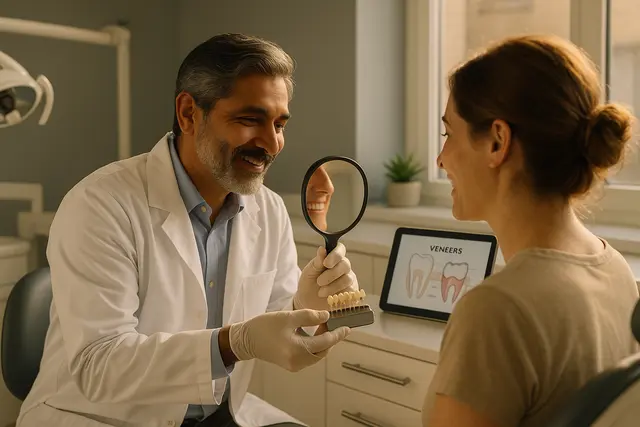Cosmetic Dentistry
7 min read
Mar 15, 2025
Cost of 6 Veneers
Dental veneers improve the appearance of teeth by covering imperfections like discoloration, chips, and minor misalignment. They are a popular cosmetic dentistry option for people looking to enhance their smile. The cost of 6 veneers depends on several factors, including material, location, and the dentist’s expertise.

Why Just Six Veneers Can Change Everything
Most smiles don’t need 28 new teeth to shine. For many people, just six veneers can take a grin from average to absolutely unforgettable. We’re talking about the “social six”, those front teeth that show when you smile, laugh, or pose for a selfie. If those are chipped, discolored, or uneven, veneers are often the fastest way to a serious glow-up. But once the sparkle settles, the big question hits: what’s the actual cost of 6 veneers?
Let’s break it all down: materials, dentist skill, insurance questions, types of veneers, and what you can expect before, during, and after the procedure. Spoiler: it’s not one-size-fits-all.
Understanding Veneers: What They Are and Why They're So Popular
A veneer is a super-thin, tooth-colored shell made to cover the front surface of your tooth. Think of it as a cosmetic upgrade that improves the appearance of your teeth, fixing chips, closing gaps, and masking deep stains. Veneers are very thin, yet durable enough to last years with proper care. Most are made of porcelain or composite resin, and each veneer is custom-made to fit and flatter your natural smile.
This isn’t just some off-the-shelf solution. Porcelain veneers, especially, are crafted to mimic the texture and reflection of natural teeth, giving you that “is it real?” kind of beauty. For those curious about alternatives, composite veneers are sculpted directly onto the tooth and cost less, but we’ll get to that.
The Dental Factors That Shape Veneer Costs
There’s no single answer to “how much do veneers cost?”, especially when you're getting six of them. Prices vary based on location, your cosmetic dentist’s expertise, lab fees, and the type of veneer used. Think of it like this: a custom suit costs more than a department store blazer, and the same rule applies to cosmetic dental work.
Also, other dental procedures may sneak into your total bill. You might need whitening for natural teeth to match the veneers, minor gum shaping, or even fillings or adjustments to support the new veneers to your teeth. Your dentist should walk you through these during your consultation.
Veneers Cost: Average Range and What Affects It
So, what’s the average cost of veneers per tooth? Across the U.S., expect a range between $900 and $2,500 per tooth, depending on materials and location. That puts the cost of 6 veneers somewhere between $5,400 and $15,000.
A few factors that also impact the cost:
Whether you choose porcelain veneers (more durable, natural-looking, and higher-end) or composite resin veneers (less expensive, but more prone to staining and wear). Do veneers stain? That’s something to consider.
The need for temporary veneers between appointments
Artistic detail (yes, truly), shade matching, shape refinement, and how seamlessly they blend with the color of your natural teeth.
Remember, even though you're paying per tooth, a six-pack of veneers often comes with bundled lab savings compared to getting one at a time.
Why the Type of Veneer You Choose Really Matters
Porcelain veneers are widely considered the gold standard in cosmetic dentistry. They resist stains, last 10–15 years, and reflect light similarly to enamel. The porcelain veneers cost more...composite veneers, but they deliver long-term value.
Composite veneers, including resin veneers, are more budget-friendly and can be done in one visit. However, they’re less durable, and may need replacing after 5–7 years. Still, they’re a great stepping-stone if you’re not ready to commit to the permanent veneers yet.
There are also no-prep veneers like Lumineers, ultra-thin and placed without shaving down the layer of enamel. But not everyone’s a candidate. Some smiles need more reshaping than these can handle.
Getting Veneers: The Process from Consultation to Smile Reveal
It all begins with a consultation. Your cosmetic dentist will examine your oral health, take digital scans, and create a wax mock-up to preview how your new veneers will look. Then comes preparation: removing a sliver of enamel (usually less than 0.5 mm) to make room for the veneer. You’ll leave that visit with temporary veneers.
A few weeks later, you return for the real deal. The veneers are applied using strong dental cement and cured with light. When veneers are placed, they’re bonded tightly to the front surface of each tooth, giving instant lift, shine, and symmetry. For a full view of what to expect, see this veneers procedure step-by-step timeline and recovery tips.
Veneers and Insurance: What You Should Know
Bad news: dental insurance rarely covers veneers because they’re considered a cosmetic procedure. However, there are exceptions. If a veneer is fixing broken teeth or significant dental issues, you might get partial reimbursement depending on your insurance coverage.
It’s best to check with your provider and bring details to your consultation. Some dentists also offer payment plans to make the total cost more manageable.
How Long Veneers Last, and What They Require From You
With great veneers comes great responsibility. How long do veneers last? Porcelain veneers typically last 10 to 15 years, while composite resin may last 5 to 7 years. Lifespan depends on proper dental care, brushing, flossing, avoiding hard candy or ice, and seeing your dentist regularly.
If you grind your teeth, a night guard can help protect your investment. The truth is, veneers are custom-made to be tough, not indestructible.
Types of Dental Veneers and What They're Best For
Here’s a snapshot of common types of dental veneers:
Porcelain veneers: Best for long-term aesthetics and strength.
Composite veneers: Great for minor fixes and tighter budgets.
Resin veneers: Similar to composite, used for fast fixes.
Lumineers: A brand of no-prep veneers with minimal drilling.
Porcelain-fused to metal veneers: Rare, but stronger for back teeth.
Each is designed to cover the front surface and correct a variety of dental veneers imperfections. The right one for you depends on your dental needs, budget, and smile goals.
Are Veneers Safe for Your Teeth? The Truth About Tooth Structure
This question comes up a lot: Do veneers ruin your teeth? The answer? No, veneers do not ruin your teeth when done properly. Skilled dentists only shave a minimal layer of enamel, and modern bonding agents protect what’s left. But if you neglect your oral health, cavities under veneers can still happen.
Also, you may wonder are veneers painful? Not typically. If you’re wondering whether veneers are worth the prep and price, think about what hiding your smile is costing you emotionally or socially. Confidence is priceless.
Are Veneers Right for You? When They're a Good Fit
If you have staining, minor crowding, gaps, worn edges, or a general feeling that your smile doesn’t match your personality, veneers can absolutely help. You don’t need a full set or a full mouth of veneers to create the perfect smile. Just six, placed with care, can completely improve the look and feel of your face.
Mild misalignment? Explore your options with veneers for crooked teeth. For alignment concerns, you may also consider veneers vs Invisalign. If you have major dental issues, though, you might need other options like dental implants or crowns or even dental bonding.
Cost Considerations: What Else Might Affect Your Total
There’s more than just the cost for a single veneer to consider. Your custom veneers may also include:
Smile design planning
Lab fabrication fees
Follow-up adjustments
Bite balancing
Whitening for untreated natural teeth
All of these can also impact the cost, but they ensure your veneers look incredible and last. It’s not just about covering imperfections, it’s about harmony.
Still Have Questions About Veneers? Here’s What to Ask Your Dentist
Come prepared to your consultation with these questions about veneers:
What type of veneer is best for my case?
How much enamel will be removed?
How do veneers combine with whitening?
Will my new veneers match my other teeth?
Are you experienced in placing veneers or Lumineers?
You deserve answers that are clear and tailored. No jargon. No guessing.
Final Thoughts
So, what do 6 veneers cost? Somewhere between $5,400 and $15,000. That’s the average cost of veneers, but the value? That’s deeply personal. Whether it’s more confidence, better photos, or finally feeling like your outside matches your inside, it’s about more than just dental work.
Six veneers may not fix the world, but they might fix the way you feel in it. If you’re serious about investing in yourself and your smile, go into your cosmetic dentist appointment informed, curious, and excited. Because this little set of six might be the best decision your teeth ever made.
How Much Do Six Veneers Typically Cost?
The cost of six veneers ranges from $5,400 to $15,000, depending on the type of material used (porcelain or composite), your dentist’s experience, lab fees, and your location. Porcelain costs more but lasts longer, while composite veneers are more affordable upfront but may need replacement sooner.
Are Six Veneers Enough for a Smile Makeover?
Yes, six veneers are often ideal for enhancing the “social six,” or the front teeth that show when you smile. If these teeth are chipped, stained, or uneven, veneers can dramatically improve symmetry, brightness, and overall appearance without treating your entire mouth.
What’s the Difference Between Porcelain and Composite Veneers?
Porcelain veneers are stain-resistant, ultra-durable, and mimic natural enamel. They last 10–15 years and offer the most natural finish. Composite veneers cost less and can be applied in one visit, but they usually last 5–7 years and may discolor more easily over time.
Does Dental Insurance Cover Veneers for Six Teeth?
Generally, no. Veneers are considered cosmetic, so most dental insurance plans don’t cover them. If the veneers are used to restore teeth damaged by trauma, partial coverage may apply. Many dentists offer financing or payment plans to make the cost more manageable.
Read Next
Related Posts

Cosmetic Dentistry
Looking for a Dentist That Whiten Teeth? Here’s What to Know First
A brighter smile can do wonders for your confidence, but finding the right dentist that whiten teeth takes more than just a quick Google search. From treatment options to experience and safety measures, there are a few key things you should know before booking that whitening appointment.
3 min read
Sep 10, 2025

Cosmetic Dentistry
What Type of Dentist Does Veneers? Here’s Who to Trust With Your Teeth
Dreaming of a flawless, photo-ready smile? Veneers can be a game-changer, but only if you choose the right expert to apply them. Understanding who’s qualified to handle this cosmetic procedure is key to getting results that look natural and last for years.
5 min read
Sep 08, 2025

Cosmetic Dentistry
Cosmetic Dentistry and Implants: How They Work Together
A confident smile can do wonders for your self-esteem, and modern dentistry offers more ways than ever to achieve it. Whether you're dealing with missing teeth or simply want a brighter, more balanced look, cosmetic dentistry and dental implants provide powerful solutions that work hand-in-hand to restore both function and aesthetics.
5 min read
Sep 05, 2025
Don’t have time to research every dentist around you?
See why 30k+ patients trusted us